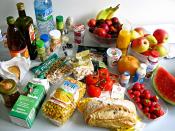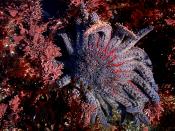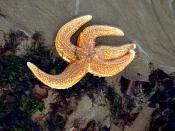outline about echinoderms, birds, and mammals !!!!
Echinoderms, Birds, and Mammals
Chapters: 34, 39, 40
I. Diversity- Echinodermata ('Spiny-Skin')
A. Characteristics
1. undergo metamorphosis from free- swimming larva to bottom dwelling adult. five radii(pentaradial symmetry)
2. endoskeleton, calcium plates, include protruding spines
3. water- vascular system (water- filled canals)
4. tube feet, aid in movement, feeding, respiration, and excretion
5. no circulatory, respiratory or excretory systems
6. nervous system, but no head or brain
7. two sexes, reproduce sexually or asexually
B. Evolution and Classification
1. 500 million years ago in Cambrian period
2. 6,000 species into five classes
a. Crinoidea ('Lily- Like')
(1) sessile, long stalk attached to sea bottom or rock
(2) mouth doesn't face sea bottom
(3) five arms divide into more arms, up to 200 in some feather- star species
(4) sticky tube feet, at end of each arm, capture food and respire
b. Asteroidea ('Star- Like')
(1) sea stars, starfish
(2) prey on oysters, clams, other organisms used as food for humans
c. Ophiuroidea ('Snake- Like')
(1) basket stars and brittle stars
(2) largest echinoderm Class
(3) long narrow arms, move quickly
(4) feed by raking in food with arms, tube feet, trapping food with tube feet or mucus between spines
d. Echinoidea ('Hedgehog- like')
(1) endoskeleton called test
(2) grind food with jaw- like Aristotle's Lantern
(3) tube feet for motion, teeth- like structures for feeding
(4) venom for protection
e. Holothuroidea
(1) armless sea cucumbers
(2) soft body, tube feet on aboral side, tentacles (modified tube feet) surround mouth and sweep in food
(3) when threatened, eject internal organs through anus (evisceration), later regenerate lost parts
II. Structure and Function (Sea Star)
A. Body plan
1. mouth located on underside of body (oral surface)
2. top of body called aboral surface...


